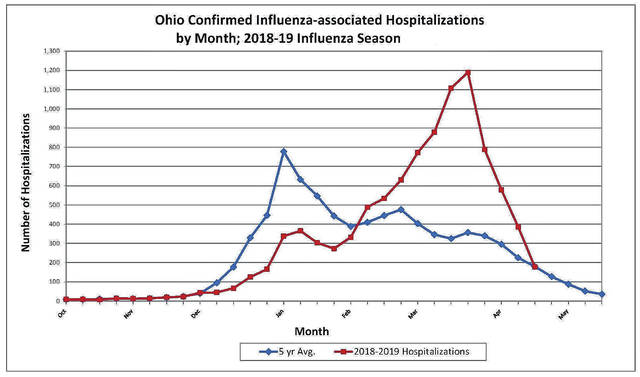
The emergence of a second strain of influenza has made this year’s flu season the longest in a decade, according to Highland County Health Commissioner Jared Warner, who said the current season started the week of Thanksgiving and is still hanging on, eclipsing the previous record of 20 weeks set just four years ago.
“Here in Ohio, we’re well above the five-year average for influenza hospitalizations,” he said. “We have seen our Ohio hospitalization numbers decline in the last few weeks, which hopefully signals an end to widespread flu activity, which we usually see come to an end in early May.”
In a recent report, the Centers for Disease Control said that 10 states, including Ohio, still have reported widespread cases of flu, while two states and the Virgin Islands report only sporadic activity.
Even though this flu season is in its 21st week, it hasn’t been as brutal compared to what the nation experienced last year, where the CDC reported that 960,000 people ended up hospitalized and an estimated 80,000 people died. Of those deaths, 185 were children.
By comparison, the CDC estimates are that this flu season resulted in 502,000 to 610,000 hospitalizations and between 34,400 to 57,300 deaths, of which 68 have been children.
What wasn’t expected was the emergence of a new strain of flu in February which led to more people being hospitalized since, as Warner put it, the strain wasn’t “well matched” with the current flu vaccine.
“We had an odd season where we had an initial peak in flu cases and then started to see that downward trend that kept pace with our five-year average,” he said. “Then all of a sudden we had a second peak, a huge spike that was out of the ordinary and was a direct result of that new strain that appeared in February, and it maxed out in late March.”
Researchers considered H1N1 to be the dominant influenza strain early on, the CDC reported, but in February another strain called H3N2 emerged and though H1N1 was the predominant cause of illness early on, H3N2 began showing up in medical sampling among patients and is responsible for prolonging the flu season.
Another highly infectious disease that can be controlled with vaccinations is measles, Warner said, which was considered eradicated in the U.S. 19 years ago due to the success of vaccinations program like those in place at the Highland County Health Department.
“Measles is one of the most infectious diseases we know of in the world,” he said. “It can be contracted by breathing virus particles from an infected person hours after they’ve left the room and that single case of measles can spawn 18 to 20 additional cases, and each of those will repeat the pattern, which means it can spread like wildfire.”
He said as of Friday there have been over 700 reported new cases of measles nationwide, more than the previous three years combined, that can carry with it serious health implications like pneumonia, encephalitis (swelling of the brain) or even death, plus an immunity issue that doctors are still trying to understand.
“It’s being called immunity amnesia in that when people catch measles, a side effect is that their immune system forgets how to protect them from diseases they already have developed an immunity for,” he said. “So once a person gets over the measles, they find themselves open to a host of other infectious diseases that they’ve lost their immunity to.”
Warner was adamant about the importance of immunizations, calling them safe and effective, and the reason that billions of lives have been saved worldwide. He emphasized that science has shown in more than 200 years that it is a valuable tool in protection against diseases.
Reach Tim Colliver at 937-402-2571.


